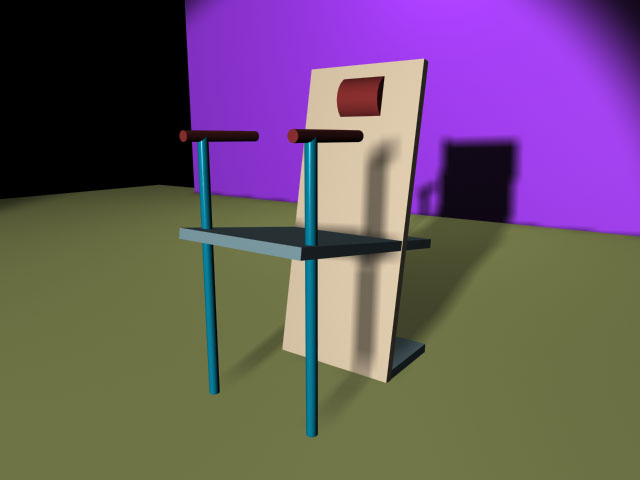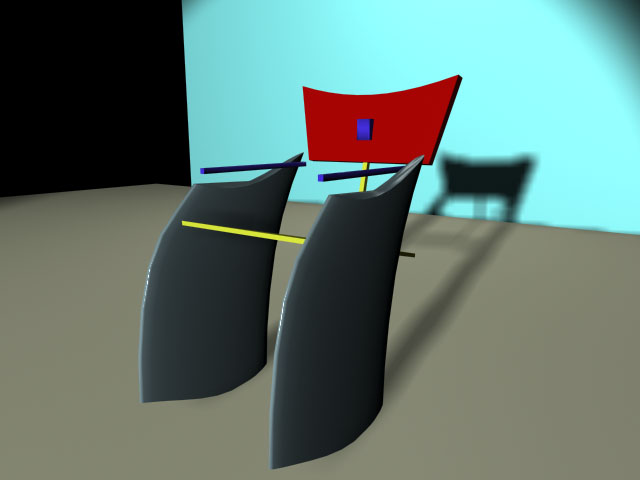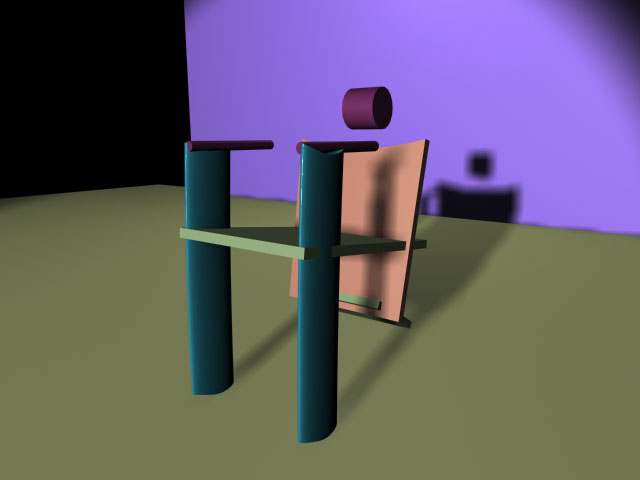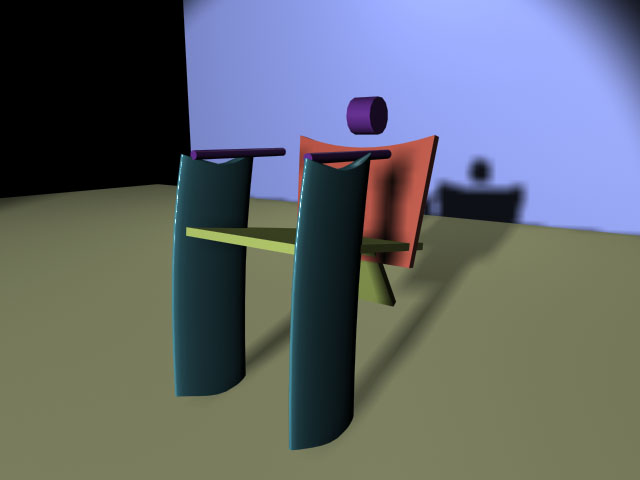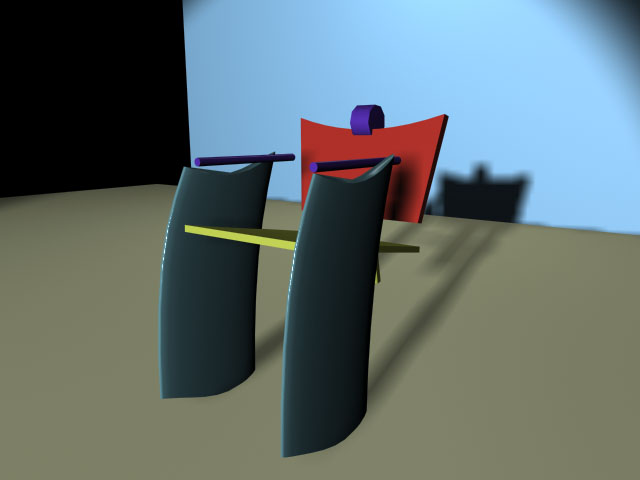JDC Spring-2000 v2 - Divergent and Convergent Thinking with CAD
Divergent and Convergent Thinking with CAD
Kathleen Gibson
Cornell Unviersity
email: kjg4@cornell.edu
Abstract
Apprehension toward computerized processes verses more fluid traditional practice cause many designers to censure computer-aided design (CAD) during conceptual and schematic design phases. But creative acts are more regulated and mechanized than designers care to believe. Topology and heuristics are presented to illustrate rule-based methods of creative inquiry. Two projects serve to demonstrate these problem-solving techniques and their use with traditional and digital media. Differences in time requirement, evaluation, and group dynamics are discussed. Findings suggest CAD may be beneficial at expanding ideation through systemic manipulation.
Introduction
Accepted for production and more objective tasks, many designers censure the use of computer-aided design (CAD) for conceptual and schematic design. Apprehension toward computerized processes over more fluid traditional design practices fuel assumptions about the rigid and conventional outcomes produced with the computer ( Gibson 1997 ). Creative acts, however, are less mysterious and more regulated than many designers want to believe. Close scrutiny of the natural world and architectural professions, as is previous design experience. Research findings report that prior experience, however, has a reflexive, negative effect on independent thinking and creative problem-solving ( Lawson 1980 ). When new design problems are viewed as comparable to previous project solutions, similar habitual responses occur. Breaking free from protracted action caused by mental blocks or conventional thought requires designers to change their cognitive patterns and routine behavior.
Traditionally, designers have relied on two popular block-busting techniques: synectics, which uses analogy to stimulate new perceptions, and brainstorming ( Laseau 1989 ). The purpose for utilizing these techniques is to expose individuals to alternate ideas and to abridge parochial mindsets. Through verbal discussion or visual sketching incidental associations emerge and are recorded for future evaluation and development. Valued in these processes is the randomness of mental and operational connections. Two distinct procedures not widely used in the design community but exercised extensively in other disciplines are topology and heuristics. These two methods rely on a mathematical system to uncover disparate and unintended outcomes to a given problem. While brainstorming and analogy operate with random links, topology and heuristics follow a predefined, linear path. It is this systemic pattern which is easily and rapidly achieved with computers that may make topology and heuristic method advantageous for designers and architects.
Topology is a method of manipulation that retains the properties of the original figure even under distortion ( March &Steadman 1994 ). Recently practiced in popular culture and often referred to as "morphing", topology formulas were historically applied in the arts and sciences. Renaissance artist Albrecht Durer utilized a Cartesian grid to chart facial characteristics and placement. By administering severe manipulations to the grid, Durer distorted a normal human profile into a grotesque reflection of the original. Later, during the 19th century, biologist Sir d'Arcy Thompson theorized connections between animal species based on their physical and proportional form. In his treatise, On Growth and Form, Thompson identified distant relationships between discrete species due to the gradual transformation of physical shape over time ( Doczi 1981 ).
In recent months More, a publication for women over forty, has been running a series of facial topologies morphing popular figures of thirty years ago with contemporary individuals. One example joins Ali McGraw with Ally McBeal (Greer 1999). Researchers studying facial beauty find greater preference for a morphed image than for the original prior to distortion ( Langlois & Roggman 1990 ). Using this inference, a composite portrait of McGraw and McBeal will be preferred over the original image of either woman. Does this logic hold true for non-facial stimuli? What might occur if, for example Corbusier's Villa Savoye was morphed with the Venice III house by Mayne and Rotondi? Would the interval representations be preferred over the originals?
Heuristics is defined by Reichardt (1968), as a set of mathematically formulated rules that equip individuals and machines to generate alternate solutions. As with topology, this technique also found favor in the arts and sciences. Artist John Pearson uses a mathematical system to compose his painted canvases. This computational idea, while regulated, still accommodates multiple possibilities within an evolutionary process ( Pearson 1976 ). In the sciences, biologist Dawkins uses heuristics to breed fictitious digital organisms, called "biomorphs", by combining patterns of genetic mutation with evolutionary selection. The procedure begins with an element of origin called the "seed". Prearranged rules are then applied to the seed generating speculative ancestral offspring ( Casti 1997 ). One can only wonder what potential family of offspring an architectural element or interior object might generate if heuristics were applied early during the design process.
Using traditional manual means, topology and heuristics are time-consuming processes and remain unsuitable choices for block-busting and design ideation. But a computer's calculation speed removes this obstacle and may make these methods viable instruments to augment problem-solving opportunities for the design disciplines.
Procedure
Design majors were assigned an exercise to study form blending and object mutation by applying computerized morphing processes. Having never used 3DStudioMAX's morphing features for design ideation, this project was approached from an experimental perspective. Preconceived expectations by students were few and when vocalized were somewhat suspicious of the procedure. Using the computer, students first constructed a "seed" model of their own design. This included investigating and applying surface materials to their digital model. Initially some minor hand sketching was completed but most of the schematic process was accomplished entirely on the computer ( Figure 1 ).
The next phase involved creating a second, yet different model of a similar size and complexity to the first objectóin this example a chair was employed. When designing their second digital model, students once again investigated alternate form and surface characteristics ( Figure 2 ).
The final phase of this project used an automated process to combine the two digital models together. Using the morphing and animation features of the software package, students created one hundred iterations that joined their two ideas together ( Figures 3 , 4 , 5 ).
Several students repeated the process with yet a third object, totaling over four hundred iterations. Several students chose to transform their digital model into a design created by their classmates. Final object mutations provided some unique marriages and unanticipated outcomes. A discussion about the process, results, and potential for design ideation concluded this experimental project.
Observations
Most experienced designers are unaware of the internal methods they employ to mentally connect random ideas into a composite whole. Of interest to this design educator and researcher is the comparison between traditional and computer-generated morphing processes and outcomes. Narrative in the following report recounts faculty observations from two student projects.
Computer Morphing. Faculty observation of students in the studio found that once initial models were designed and constructed, morphing them together was a relatively easy task. This experience created an excitement among the students as they imagined the visual outcome of their model joined with alternate ideas or models created by their classmates. These trials created some unique object marriages. Students that historically quit too early in the ideation phase or routinely experience persisting mental blocks found this digital process helpful for stimulating experimentation. Another noticeable outcome of using computer morphing for design was in the area of evaluation. Team dynamics and interaction can challenge students' psyches, especially when the group discards their ideas. Using the computer appeared to remove individual personalities from the initial equation thereby giving each student equal participation at this preliminary stage in the design process. This method seemed to encourage explorative behavior and kept students focused away from prejudging ideas.
Toward the end of this exercise when evaluation did occur, there were hundreds of images for students to sort through. Some students were overwhelmed by the quantity of iterations; others became keenly focused on every minute detail. Distinctions between image thirty-six and forty-two, for example, may not initially appear to be significant but students could explain the differences and substantiate one selection over another.
Human Morphing. This second project was completed under different circumstances and therefore serves only as a mechanism to illustrate the use of traditional merging processes. A weekend program-wide charette, interior design majors were asked to design a series of wall panels in an effort to transform the character of a college dining facility. During the initial phase, students developed individual ideas using traditional techniques - sketching and cardboard study models ( Figure 6 ).

Figure 6Later in the process, student teams united their diverse ideas into a composite panel design ( Figure 7 ).
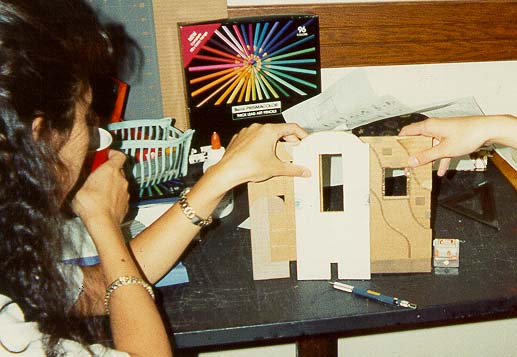
Figure 7
Group panels were placed into the cafeteria site model for further assessment ( Figure 8 ). This project concluded with a student presentation to the College Dean.
Faculty observation of students using traditional processes during the charette found students enjoyed the initial project phase where they designed their own individual panels. Challenges arose as teams were formed and students needed to combine several design solutions into a single composite. Exacerbated by time constraints, some students' egos were bruised when their individual ideas were excessively condensed in the team panel solution. One group found it easier to begin anew rather than try to subjectively combine disparate ideas into one. Verbal negotiation became an important component when using this manual merging process.
Evaluation was an integral component throughout the schematic process. Individual students, student teams, and faculty members regularly assessed design ideas through verbal and visual means. Due to periodic evaluations, the project's conclusion became more of a celebratory experience than one of final judgement.
Discussion
Comparing these two projects, one applying manual transformation and the other digital, similarities and differences in process and performance were observed by the instructor. Both projects required a dynamic use of divergent and convergent design skills from participants but each ideation method presented a different sequence of cognitive activity. Students participating in the charette utilized brainstorming techniques to initiate a vast number of ideas to the assigned problem. Self-assessment of ideas was an integral and repetitive process during this phase of ideation and culminated in their selection of three finalists for further study. The opposite held true for students that utilized the automated topology method, i.e., morphing. In this exercise, participants began with just two or three ideas and used the computer to generate an abundance of hybrids. Students' self-assessment was absent during this initial phase of ideation. This behavior may have resulted due to the novelty of the morphing process or the difficulty of responding to the extensive number of images created in less than one minute.
The frequency of evaluation also varied between both ideation methods. Participants in the charette continually judged their design schema throughout the process as a way to narrow their choices and fine-tune design ideas. Again, the opposite held true for students using the computer for ideation. Evaluation was not an integral part of this process and therefore occurred less frequently. After the morphing procedure was complete, students viewed all the images generated by the computer in total. Selection of the participants' best two representations involved an immense amount of time. The issue of extensive evaluation time may have occurred from the large quantity of morphed images to compare, the act of reserving judgment until the end, or a combination of both.
The final point of discussion examines the effect each ideation method had on the process outcome. Charette participants using the traditional model of brainstorming applied more subjective and contemplative criteria to assess their ideas. This method was contingent on students' personal values and therefore the evolution of combining design ideas together did not follow a straight, predictable path nor was it impartial at integrating equal portions of several ideas together. On the other hand, computerized topology required minimal human input due to the predetermined mathematical processes. Students were confident that the computer would accurately combine divergent ideas without giving preference to one over the other. Synthesizing ideas together in a logical and objective manner found favor with several students.
Summary
This case study does not propose that one ideation method is superior to the other. What this case study suggests is that CAD's mechanized processes can expand ideation opportunities for the design discipline. Using CAD as a tool during schematics may release the designer from habitual and routine patterns so that alternate connections or new concepts may arise to re-occurring problems. Although this case study observed some positive results, they remain suspect without more objective examination. Fundamental are follow-up investigations that utilize identical testing stimuli and control for external factors. There is also a need to explore how to best combine the two methods and whether a composite is more beneficial to design ideation than traditional or digital methods alone.
References
Casti, J. (1997). Would-Be Worlds: How Simulation is Changing the Frontiers of Science. New York: John Wiley and Sons, Inc.
Doczi, G. (1970). The Power of Limits: Proportional Harmonies in Nature, Art and Architecture. Boston, Mass.: Shambhala Publications, Inc.
Gibson, K. (1997). Results from national survey of interior design faculty at FIDER-accredited institutions collected in 1996-97. Unpublished.
Laseau, P. (1989). Graphic Thinking for Architects and Designers, Second Edition. New York: Van Nostrand Reinhold.
Lawson, B. (1980). How Designers Think. London: The Architectural Press Ltd.
Langlois, J., Roggman, L. (1990). Attractive faces are only average. Psychological Science , 1(2), 115-121.
March, L. and Steadman, P. (1994). The Geometry of the Environment. London: Methuen.
Pearson, J. (1976). John Pearson: Works from 1968-76. Ashland, Ohio: Ashland College.
